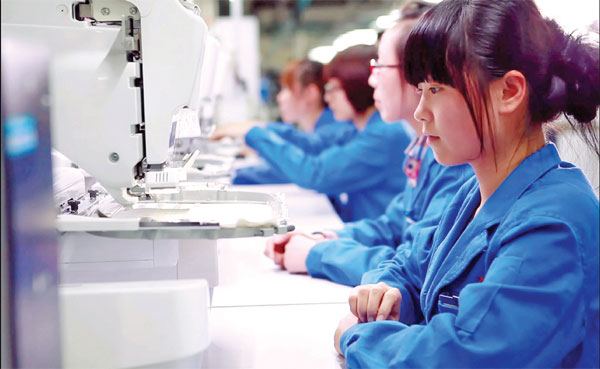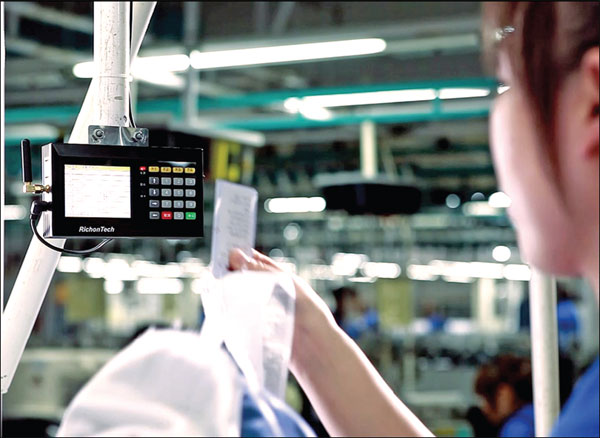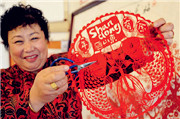Garment maker profits with customized approach
By David Blair ( China Daily Europe )
Updated: 2017-06-09
|
|||||||||
Behind company's good numbers is a unique internet model that includes zero inventory
Garment manufacturing is usually thought to be the prototypical low-wage industry. Companies in the industry move to wherever the labor is cheapest.
Qingdao Kutesmart Co in East China's Shandong province, is proving that by using the right technology and a smart business model, it's possible to be highly competitive in a traditional industry, even as wages rise.
The "smile curve", proposed in the early 1990s by Stan Shih, the founder of Acer Inc in Taiwan, says that most of the profits from a product are captured by designers, brand owners or retail channels, not by the manufacturers. By contrast, Zhang Daili, chairman of Kutesmart, argues that by using direct contacts with customers and efficient production processes, manufacturers can get most of the profits.
|
Employees at Qingdao Kutesmart Co in Shandong province. Their wages are about 20 percent higher than the clothing making industry average. Photos Provided to China Daily |
|
Qingdao Kutesmart Co became competitive in a traditional industry by using the right technology and a smart business model. |
Through its Red Collar and Cotte brands, the company's "customer-to-manufacturer" information-intensive, and integrated process boosts profits by providing highly customized business suits below mass market off-the-shelf costs, cutting out the middlemen. Customers can either go to one of the company's brick-and-mortar measurement sites or give detailed measurements online. They can also choose such things as the type of cloth, styles and stitching. This personalized information is then fed into Kutesmart's automated precision cutting machines, then to the embroiders, joiners, ironers and others. The suit is electronically tracked until it is ready for the customer, seven days later.
According to research by Lu Yinghan of Jinan University Management School, Kutesmart's profits increased by more than 25 percent per year in 2014 and 2015. By contrast, public companies in the clothing industry saw average revenue fall by 2.6 percent and net profits fall by 3.6 percent in those years. The company is privately held and does not disclose profit information directly.
Kutesmart employs about 3,000 people, paying wages approximately 20 percent higher than the industry average, according to He Wei, a company representative in the branding and public relations department.
New hires, who are mostly Shandong residents, go through a training process to learn Kutesmart's process. They learn to receive order information from the database and to take that information to produce highly customized products. They focus on an "internet working model", according to He. "The value of employees is based entirely on the degree to which they satisfy customer demand. The company's joint trading platform is really a link between the customers and the staff," she says.
Started in 1995, the company at first a traditional clothing manufacturer. Zhang, the Kutesmart chairman, worked for many years developing what the company calls its "source data engineering" process, which links custom orders to a finished product.
"SDE deeply integrates industry and information, using production process networking and intelligent management to achieve synchronous production of personalized products. It is data-driven, on-demand, zero-inventory, with a flat management structure - a very lean production process," says He. The company uses radio frequency identification tags to track products through the process.
In a company video, Zhang says: "In 2003, Chinese were struggling for razor-thin margins from processing orders from New York. Red Collar used to be a traditional enterprise group. As contradictions between production and the market increased, the only way out was to open up a new path by ourselves. We began to consider the transformation from mass production to personalized customization. It lasted 12 years and cost hundreds of millions. Based on deep integration of informatization and industrialization, we formed a complete internet-of-things system and made it our core value."
Zhang Yunlan, Kutesmart's president and daughter of the founder, says in the video: "Tactically, source refers to customer demand. Source theory means that all the behavior of the enterprise takes demand as its source."
Zhang Daili stresses the effect this has on management structures.
"We break barriers between departments and sections, since the value chain is driven entirely by demand data. The goal of each person is to satisfy customer demand. They no longer safeguard the interests of their own departments, but pay more attention to customers," he says.
Chen Shaozhi, a senior journalist who heads the Made in China 2025 team at Xinhua News Agency's Economy and the Nation Weekly, stresses that the company's success is based on its appropriate use of information systems.
"Kutesmart uses typical machines, but they do customized production at the same time. Some companies might think about using robots for this role. Kutesmart did not reduce its worker count, but enhanced its profit margin a lot. This model is very appropriate for China's current situation," Chen says.
Kutesmart has created another core line of business in which it advises other manufacturers about the source data engineering production process.
"At present, we have contracted pilot upgrading plans with nearly 100 enterprises in jeans, clothing, hats, shoes, furniture, casting and electrical appliances," He says.
"Enterprises can quickly copy successful techniques to achieve transformation and upgrading. After three months of upgrading, we can increase efficiency by more than 30 percent and cut costs by more than 20 percent. High profits and low costs are made possible by zero inventory and high turnover."
In the company video, Zhang Yunlan says: "Around 2014, the inventory in China's clothing market was conservatively estimated to be worth about 400 billion yuan ($59 billion, 52 billion euros, £46 billion) - enough to cover three years of sales in the Chinese market. But Kutesmart managed to have zero inventory. When other garment enterprises were suffering because of high inventory, Kutesmart achieved rapid growth year-on-year.
"Behind these good numbers is the unique internet-industry model of this enterprise��manufacturing personalized products by means of industrialization, efficiency, and cost-reduction."
davidblair@chinadaily.com.cn
(China Daily European Weekly 06/09/2017 page8)






